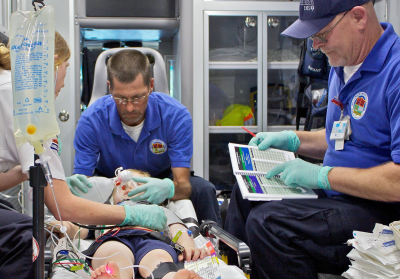Innovative Design
Why is Our Design So Unique?
All RightDose solutions have been designed using a new presentation format paradigm, designed to focus on providing the ultimate level of patient safety and dose accuracy.
A resent peer reviewed research abstract published on UCLA’s Prehospital Care Research Forum demonstrates that the new design format changes were highly effective. The research, published in the Spring of 2016 and sponsored by the State of Tennessee Office of EMS, Walters State Community College and TN EMSC, reveals pediatric medication volume errors were reduced from a staggering 65% down to only 4%, the lowest of any currently published medication error research.
Unlike most all drugs dosing solution available today, RightDose uses the new format which organizes by drug name, while most all other dosing solutions are organized by using commonly used weight or age ranges. The common and widely used ‘weight or age centric’ method of presenting doses was introduced by the popular ‘Broselow Tape’ developed by Dr. James Broselow in 1985. It displays the doses for drugs in an alphabetical list or table format inside each of 9 specific weight related groups.

For several years, RightDose was originally developed and field tested using the ‘age/weight' per page format. To specifically overcome possible ‘finger pointing’ errors, we designed & tested the new ‘drug per page' format. In this new format, each page represents a single drug and lists all the drug weight and volume doses for that drug using 25 weight categories from 3 kg to 70 kg. After evaluating and considering field testing feedback, the new 'drug per page' format replaced the traditional ‘age/weight per page’ format as it was found to provide distinct safety advantages and other benefits over the traditional ‘age/weight page’ based guides.
Our Design Advantages?
SAFETY - Most importantly, the new ‘drug per page’ format demonstrated increased patient safety by eliminating the possibility of significant volume errors being introduced when a caregiver was selecting a dose from a list of multiple drug doses listed in a table format all on the same page. This was referred to above as ‘finger pointing’ errors. Being one line off, either above or below the desired drug choice in a list, could introduce a significant mL volume error, with multiples of 10, 100 or even greater being possible. Color differentiating each line was helpful, it did not prove to be error proof under field conditions. If a caregiver were a line off in the drug per page format, there would be a small insignificant volume variance in the drug administered.
PAGE REPLACEMENTS - Drug shortages have become a common occurrence, thus requiring a supplier change and perhaps resulting in concentration change as well. Also, protocol changes are becoming more frequent, requiring drug additions or dose changes. Both these conditions required printed dosing guides to be updated. Updating a single concentration, dose or formulary in a 'age/weight per page' guide, where every drug appears on every page, requires the purchase of an entire replacement guide – for one small change. Comparing the long term costs of printed guides over five years makes the 'drug per page' guides a considerably more cost-effective solution. They are easier to maintain and update and require only pages replacements or additional page inserts.

ADULT DOSING – The drug per page format facilitates the use of weight based medications for adults that use the same dose per kg as a child. The pediatric/adult drug page is expanded to two pages and covers 50 weigh groups from 3 kg to 220 kg. If the adult dose is different than the pediatric dose, a separate adult page can be created with 25 weight ranges from 70 kg to 220 kg.
ADMINISTRATION NOTES – Add special instructions from your protocols/formulary for each individual drug. There is no need to condense pertinent administration notes or use abbreviations that can be easily misinterpreted. Ample space is available in the Notes/Special Instructions area for each drug.
DRIPS & FLUIDS – Drip and fluid calculations are even more complex than single doses. We have adopted using the drug page format for any drip for patients requiring an infusion dose determined by weight and drip rate. Up to ten separate dose levels are available to develop a drip chart for all weight ranges. Individual drip chart pages are available for PEDS, PEDS/ADULT or just ADULTS.


